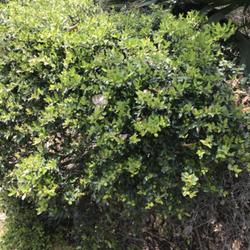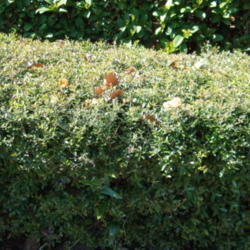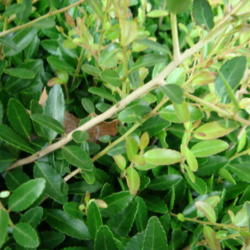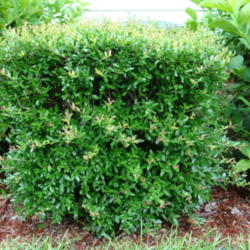| Plant Habit: | Shrub |
| Life cycle: | Perennial |
| Sun Requirements: | Full Sun Full Sun to Partial Shade Partial or Dappled Shade Partial Shade to Full Shade |
| Water Preferences: | Wet Mesic Mesic Dry Mesic |
| Soil pH Preferences: | Moderately acid (5.6 – 6.0) Slightly acid (6.1 – 6.5) Neutral (6.6 – 7.3) Slightly alkaline (7.4 – 7.8) |
| Minimum cold hardiness: | Zone 7a -17.8 °C (0 °F) to -15 °C (5 °F) |
| Maximum recommended zone: | Zone 9b |
| Plant Height: | 4 to 7 feet |
| Plant Spread: | 6 to 10 feet |
| Leaves: | Evergreen Broadleaf |
| Fruit: | Showy Edible to birds |
| Flowers: | Inconspicuous Fragrant Other: Female |
| Flower Color: | White |
| Bloom Size: | Under 1" |
| Flower Time: | Spring |
| Inflorescence Height: | N/A |
| Foliage Mound Height: | N/A |
| Suitable Locations: | Xeriscapic Espalier Topiary |
| Uses: | Windbreak or Hedge Provides winter interest Erosion control Groundcover |
| Wildlife Attractant: | Bees Birds |
| Resistances: | Tolerates dry shade Humidity tolerant Drought tolerant Salt tolerant |
| Propagation: Seeds: | Stratify seeds: 30-60 days @ 68-86 degrees followed by 60-90 days @ 41 degrees Suitable for wintersowing Sow in situ |
| Propagation: Other methods: | Cuttings: Stem Other: sprouts from roots or lower trunk - ground layering is quite possible |
| Pollinators: | Bees |
| Miscellaneous: | Dioecious |





« Add a new plant to the database
» Search the Ilex Database: by characteristics or by cultivar name
« See the general plant entry for Ilex